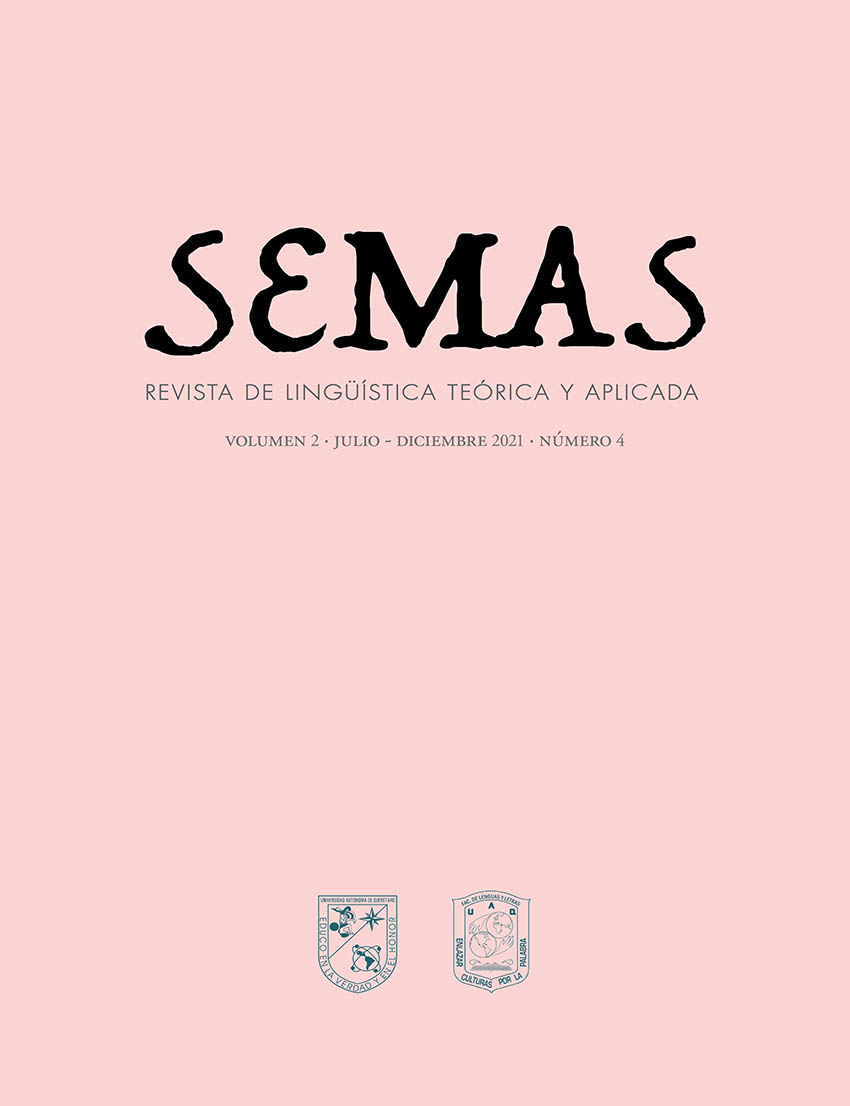Abstract
This paper describes the semantic, discursive, and grammatical conditions in which plural agreement in Ñätho verbs occurs with 3rd person participants in data from lin-guistic corpora. Plural number agreement seems to be governed by two typologically relevant hierarchies: animacy and topicality, in which referential, topical humans expressed before the verb are more frequently cross-referenced in it. In Ñätho, unlike in other Western Otomi languages, grammatical or thematic roles do not seem to play any important role in 3rd person plural agreement in the verb.
References
Andrews, H. (1993). The Function of Verb Prefixes in Southwestern Otomi. Arlington: Instituto Lingüístico de Verano-Universidad de Texas en Arlington.
Bartholomew, D. A. (2010). “Notas sobre la gramática del Hñähñu (otomí)”. En L. Hernández, M. Victoria, & D. Sinclair, Diccionario del hñähñu (otomí) del Valle del Mezquital, estado de Hidalgo (pp. 497-516). México DF: Instituto Lingüístico de Verano.
Bickel, B. (2010). “Grammatical relations typology”. En J. J. Song (Ed.), The Oxford Handbook of Linguistic Typology (pp. 399-444). Oxford: Oxford University Press.
Bisang, W. (2006). “From meaning to syntax - semantic roles and beyond”. En I. Bornkessel, M. Schlesewsky, B. Comrie, & A. D. Friederici (Eds.), Semantic Role Universals and Argument Linking. Theoretical, Typological, and Psycholinguistic Perspectives (pp. 191-236). Berlín: Mouton de Gruyter.
Bossong, G. (2006). “Meaning, form and function in basic case roles”. En I. Bor-nkessel, M. Schlesewsky, B. Comrie, & A. D. Friederici (Eds.), Semantic Role Universals and Argument Linking. Theoretical, Typological, and Psycholinguistic Perspectives (pp. 237-262). Berlín: Mouton de Gruyter.
Corbett, G. G. (2004). Number. Cambridge: Cambridge University Press.
Crystal, D. (2008). A Dictionary of Linguistics and Phonetics. Oxford: Blackwell.
Dryer, M. S. (1986). “Primary Objects, Secondary Objects, and Antidative”. Language, 62(4), pp. 808-845.Ebert, C., & Hinterwimmer, S. (2013). “Introduction”. En C. Ebert, & S. Hinterwimmer (Eds.), Different Kinds of Specificity Across Languages [eBook] (pp. 1-10). Springer.
Givón, T. (1983). “Introduction”. En T. Givón (Ed.), Topic continuity in discourse: A quantitative cross-linguistic study (pp. 5-39). Ámsterdam/Filadelfia: John Benjamins.
Givón, T. (2001). Syntax: An introduction (Vol . 1). Ámsterdam: John Benjamins.
Haspelmath, M. (2005). “Argument Marking in Ditransitive Alignment Types”. Linguistic Discovery, 3(1), pp. 1-21.
Hekking, E., & Andrés de Jesús, S. (1984). Gramática otomí. Querétaro: Universidad Autónoma de Querétaro.
Hernández Cruz, L., Victoria Torquemada, M., & Sinclair Crawford, D. (2010). Diccionario del hñähñu (otomí) del Valle del Mezquital. México: Instituto Lingüístico de Verano.
Kittilä, S., Västi, K., & Ylikoski, J. (2011). “Introduction to case, animacy and semantic roles”. En S. Kittilä, K. Västi, & J. Ylikoski (Eds.), Case, Animacy and Semantic Roles (pp. 1-26). Ámsterdam/Filadelfia: John Benjamins.
Lastra, Y. (1998). “El número en los dialectos otomíes”. Boletín de Filología de la Universidad de Chile, 37, pp. 645-658.
LBI. (2010). El Nuevo Testamento en el otomí del estado de México. Wycliffe Bible Translators, Inc.
Palancar, E. L. (2009). Gramática y textos del Hñöñhö: Otomí de San Ildefonso Tultepec, Querétaro. Ciudad de México: Plaza y Valdés.
Palancar, E. L. (2004). “Middle voice in Otomi”. International Journal of American Linguistics, 70(1), pp. 52-85.
Palancar, E. L. (2011). “Revisiting the conjugation classes of Eastern Highlands O t om i ”. Sprachtypologie und Universalienforschung, 64(3), pp. 213-236.
Palancar, E. L. (2013). “The evolution of number in Otomi: The many faces of the dual”. Studies in Language, 37(1), pp. 94-142.
Voigtlander, K., & Echegoyen, A. (1985). Luces contemporáneas del otomí Gramática del otomí de La Sierra. Ciudad de México: Instituto Lingüístico de Verano.

This work is licensed under a Creative Commons Attribution 4.0 International License.
Copyright (c) 2021 Semas

